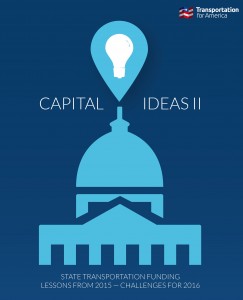In addition to the recommendations detailed in our first Capital Ideas report, successes and failures from the 2015 state legislative sessions provide illustrative lessons, especially for those states looking to take the issue up in 2016.
Lessons learned in 2015
Continually and persuasively make the case
Legislators and stakeholders must continually engage in critical transportation issues. It’s a challenge to ramp up and pass a bill in a short timeframe when no one has actively been making the case and educating the decision-makers and public in the time preceding.
Necessary reforms should be part of new funding legislation
Legislators should enact reforms to make state transportation funding decisions more transparent and show how the state will spend money to meet public needs and goals. Effectively demonstrating the value of investing in transportation will help build the case for more funding for transportation, but new funding laws that fail to steer funding to today’s critical needs or help people see the tangible, measurable benefits of transportation investments are a huge hindrance to building support for any new transportation spending. The best time to enact these reforms may be before a campaign for new funding (as with this year’s bill in Louisiana). But critical reforms can also come with new funding, or following (as it has in Virginia) to show taxpayers that the new funds are being well-spent on the best possible projects.
Strong champions paired with a diverse coalition are a winning recipe
States are most likely to succeed in changing transportation funding and policy when they have strong champions who are willing to spend political capital, backed by a diverse coalition that makes transportation a priority year after year.
Confidence in the system equals support for new revenue
Investing in transportation is more popular when voters have faith in how the funds are spent and see the improvements made. Voters approve 70 percent of transportation-related ballot measures and 98 percent of legislators in 10 states that voted to increase transportation funding since 2012 won their next primary. If public confidence is low, lawmakers have a vested interest in improving transparency and accountability to improve confidence and build support for new revenue. For example, Virginia’s active steps to improve how new revenues are spent could be paid back tenfold if they need to raise revenue again in the coming years.
Challenges and opportunities ahead in 2016 and beyond
Increasing fuel taxes — even indexing them to inflation — still isn’t a long-term solution
While dozens of states have moved to raise new revenue and many have deliberately pegged rates to inflation or the increasing price of fuel to help ensure that revenues don’t stay static, the fundamental shift in our vehicle fleet’s efficiency and how much we drive means that fuel taxes based only on consumption or driving amounts won’t be enough to cover our needs over the long term. Many of the recent funding increases are just a first step to make up years of lost revenue due to static tax rates and neglected investment in transportation by the states. With vehicle fuel economy climbing to 54 mpg by 2025 under new federal rules and greater use of other non-car options, the trend of drivers buying less gas will only accelerate.
Fees on alternative fuel vehicles will likely continue
Charging electric vehicle owners a flat fee is politically easy due to the small number of electric vehicle drivers affected (in comparison to a gas tax increase), but this fee still doesn’t offer a sustainable or balanced way to raise revenue from drivers of alternative fuel vehicles. If this market does rapidly expand states must consider comprehensive alternatives such as road usage charges or vehicle-miles-traveled fees. On the plus side, in states with a constitutional requirement that gas tax funds go only to highways, revenues from this fee can often be spent on any type of need. For example, in Washington electric vehicle fee revenue is going to a new electric vehicle charging station infrastructure bank.
There’s still a long way to go on rethinking old formulas and instituting reforms
Though some places have made progress on this count and it’s one of our keys to a successful funding package, it’s clearly still a challenge for legislators to address the ways these funds are spent. Funding formulas in many states have been on autopilot for decades and lack transparency or accountability for state dollars. Virginia’s reform bill that passed this year — along with recent reform measures in Louisiana, Texas, Tennessee and Massachusetts — offer models for states to adopt.
States should fund all of the needs in their states, not just highways
Most of the packages this year involved funds largely dedicated to highway projects. While many states have outdated restrictions that limit certain fuel tax or related revenues to spending on roads, legislatures must find ways to use state funds to finance the multimodal transportation system they need to stay economically competitive. States that ignore this do so at their long-term economic peril. While T4America supports the concept of states enabling local voters to tax themselves for transportation and transit specifically, states should not neglect their urban and rural transit needs by pushing all responsibility to local government or local voters. Moving people from place to place and connecting them to jobs and opportunity — whether by a highway or a transit line — is always in the state’s interest and new funding or policy legislation should reflect that.






